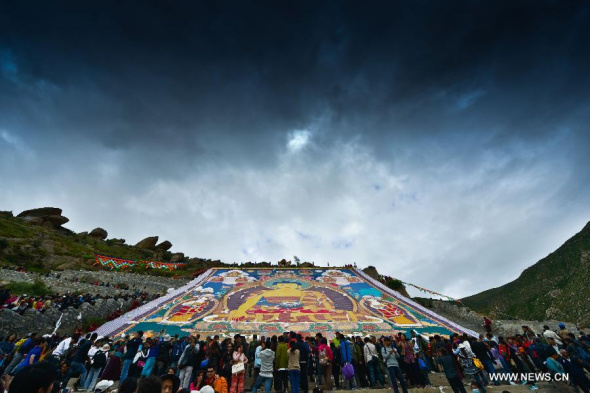

Buddhists and tourists participate in the sacred "sunning of the Buddha" ceremony to mark the start of the annual Shoton festival at the Zhaibung (Drepung) Monastery in Lhasa, capital of southwest China's Tibet Autonomous Region, Aug. 6, 2013. The Shoton festival dates back to the 11th century and was originally a religious occasion, when local people offered yogurt to monks who had finished their meditation retreats. Since the 17th century, the festival has become a celebration featuring both religious rituals and civil entertainment. It is now considered as one of the most important festivals on the Tibetan calendar. (Xinhua/Purbu Zhaxi)
Tuesday marks the start of the Shoton Festival, one of the most important days on the Tibetan calendar. Hundreds of thousands of people have gathered at the Drepung Monastery in Lhasa to pay respect.
A solemn start for an auspicious day.
A chance to talk to the Buddha to pray for a happy life.
Early in the morning, lamas at Drepung Monastery prepare to welcome the giant painting, or thangka, of the Buddha for its annual unfolding. It's the most important religious event here in Lhasa.
"This Buddha Exhibition of Drepung Monastery has a history of over 300 years. It means a lot to both the pilgrims and visitors." Awang Qunzin, Monk, Drepung Monastery said.
After the major ceremony at the main assembly hall, lamas carry the huge thangka scroll to the exhibition site. It's on the mountain side behind the hall.
Crowds of believers and tourists have come to pray, receive a blessing, and view the magnificent portrait. To get a good vantage point, most arrived long before the ceremony.
Slowly, the first glimmer of light appears on the mountain, and over the city of more than 14-hundred years of history. The atmosphere is joyous and reverent.
The giant portrait of Sakyamuni, the founder of Buddhism, is finally unveiled. The masterpiece measures some 400 square meters.
Pilgrims flood towards the portrait to pay their respects. They throw white silk cloths called khadas, symbols of purity and devotion. And they walk around the mountain, hoping to be blessed.
"It is peaceful. It is full of positive power and encourages me a lot." Tibetan Resident said.
For Tibetans, the ceremony is a cornerstone of the expression of their faith. And for tourists, it's an experience of Tibet's profound traditional culture.
"Originally, the Buddha exhibition ceremony was purely religious. Now, it has become the opening of the yearly Shoton festival. To this day the spiritual connection remains strong -- a connection that cannot be fully explained in words, but can be felt deeply in Tibetan hearts. Han Bin, CCTV from Drung Monastery." Han Bin said.
Copyright ©1999-2018
Chinanews.com. All rights reserved.
Reproduction in whole or in part without permission is prohibited.